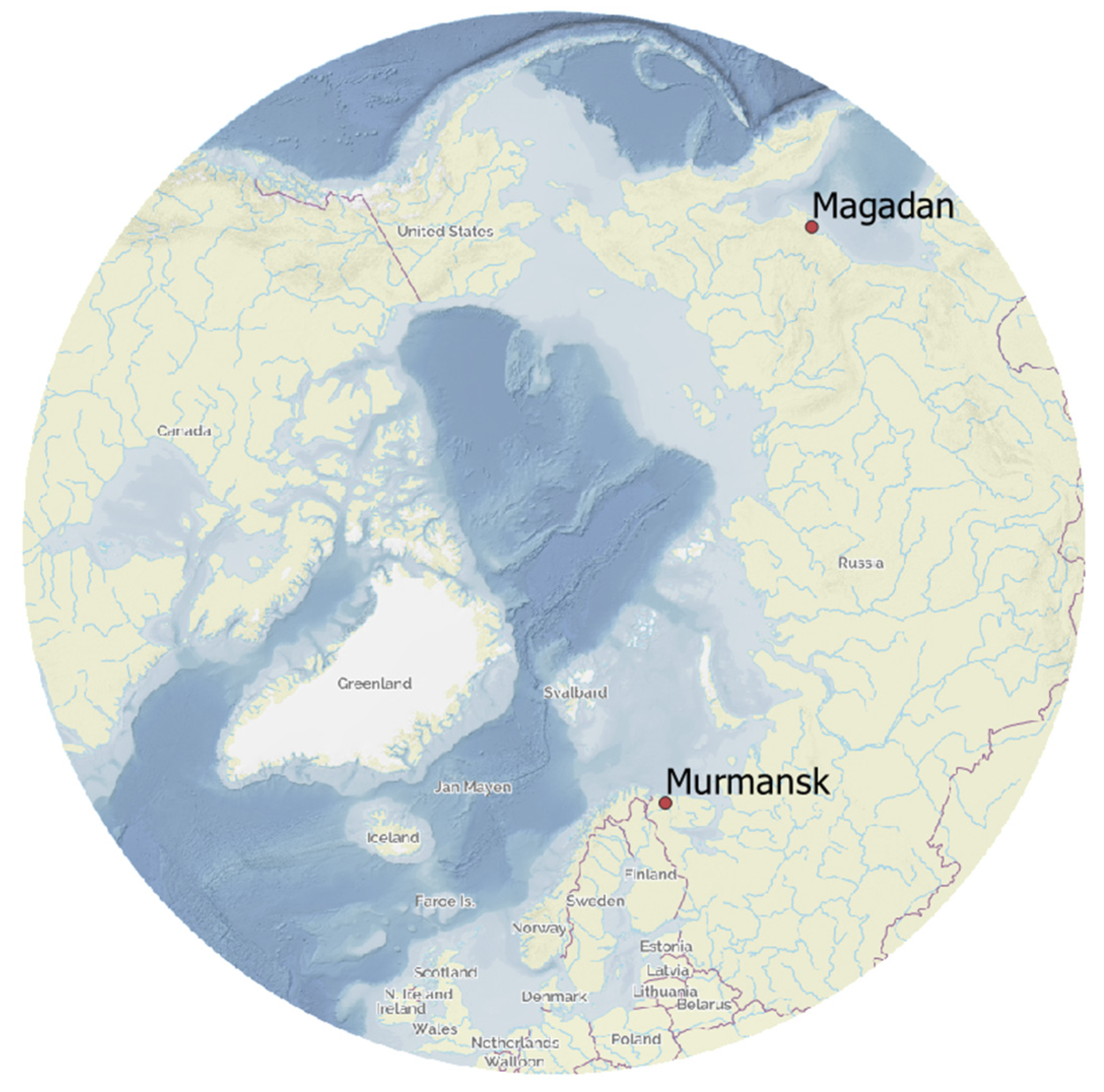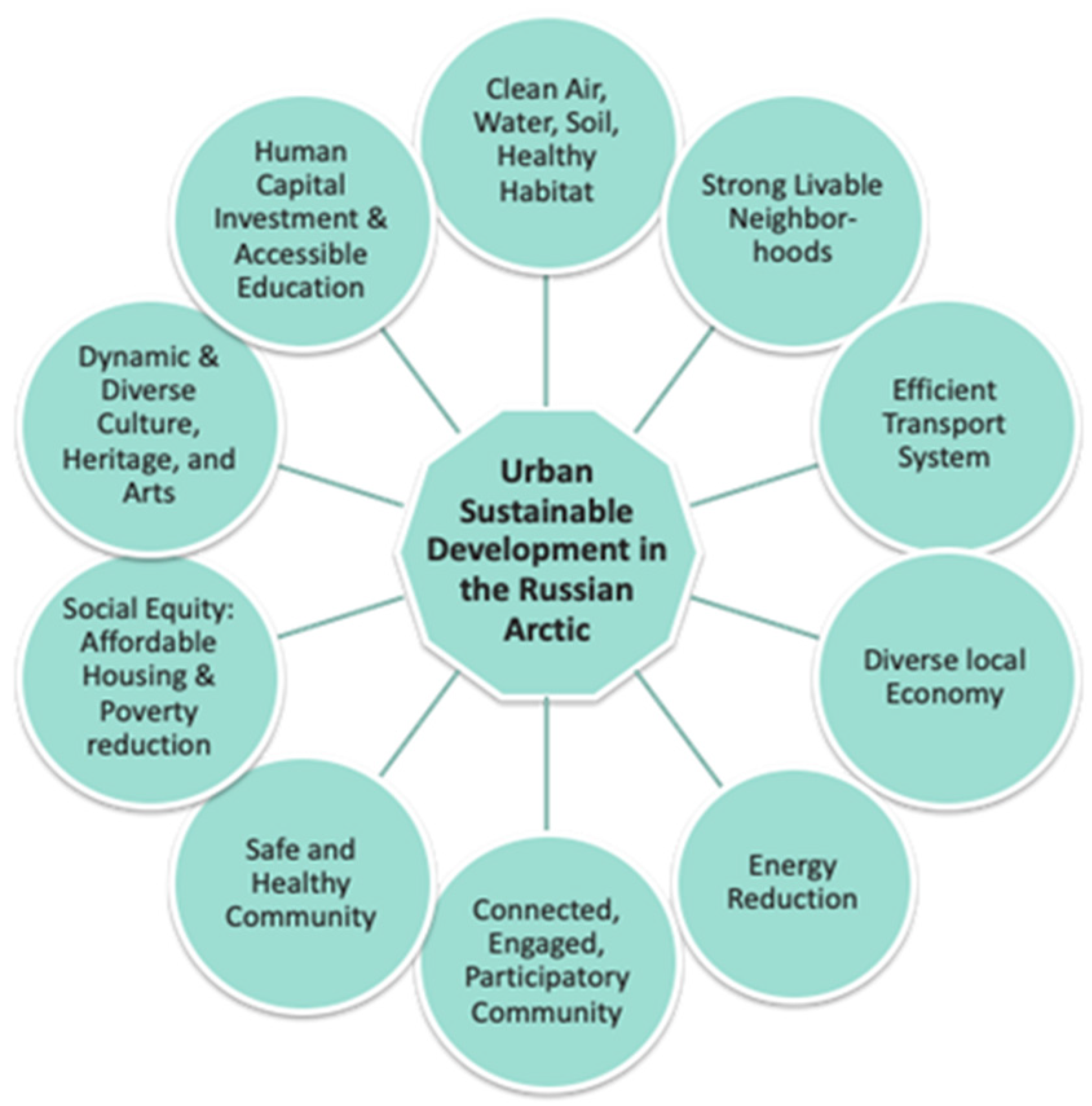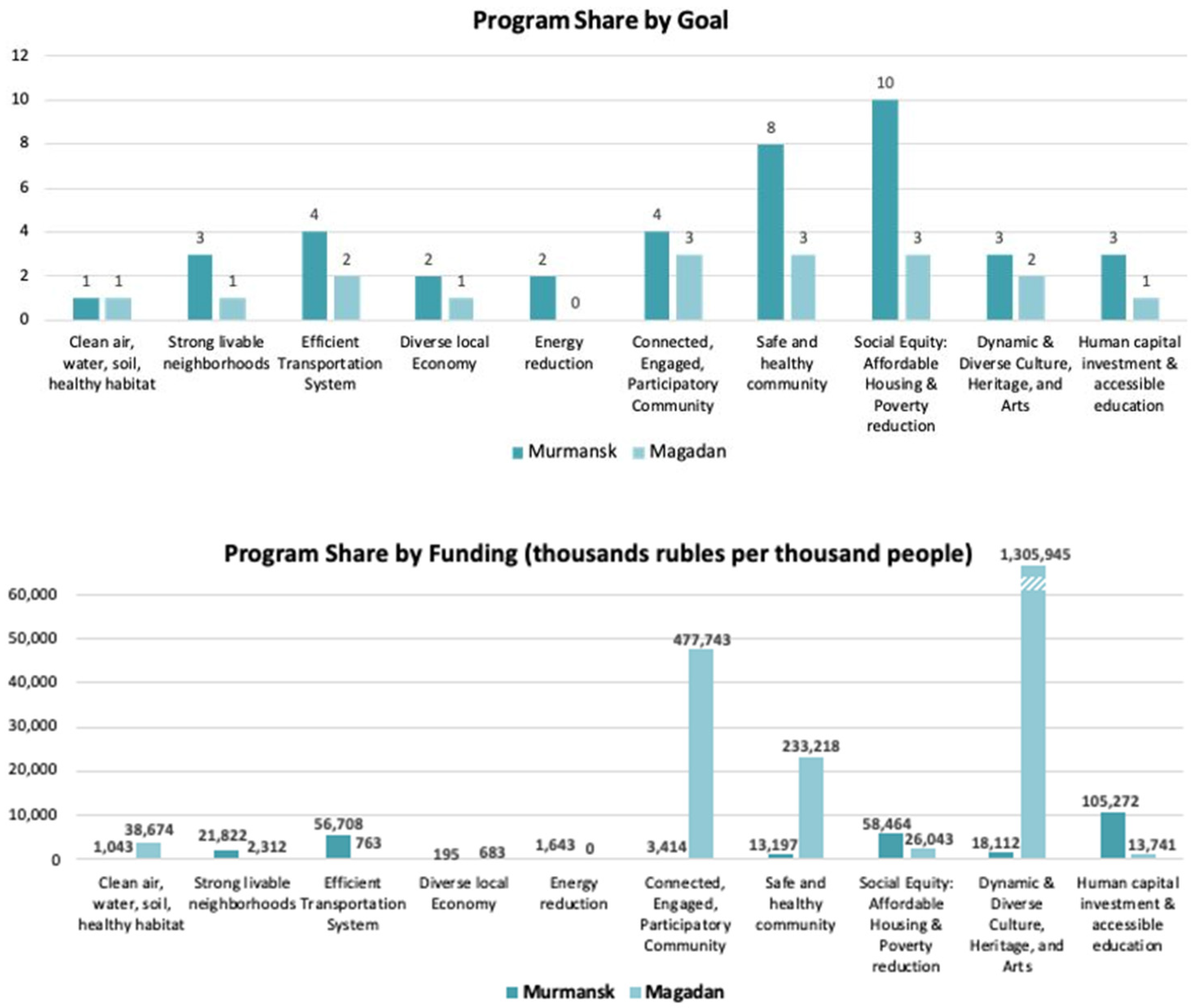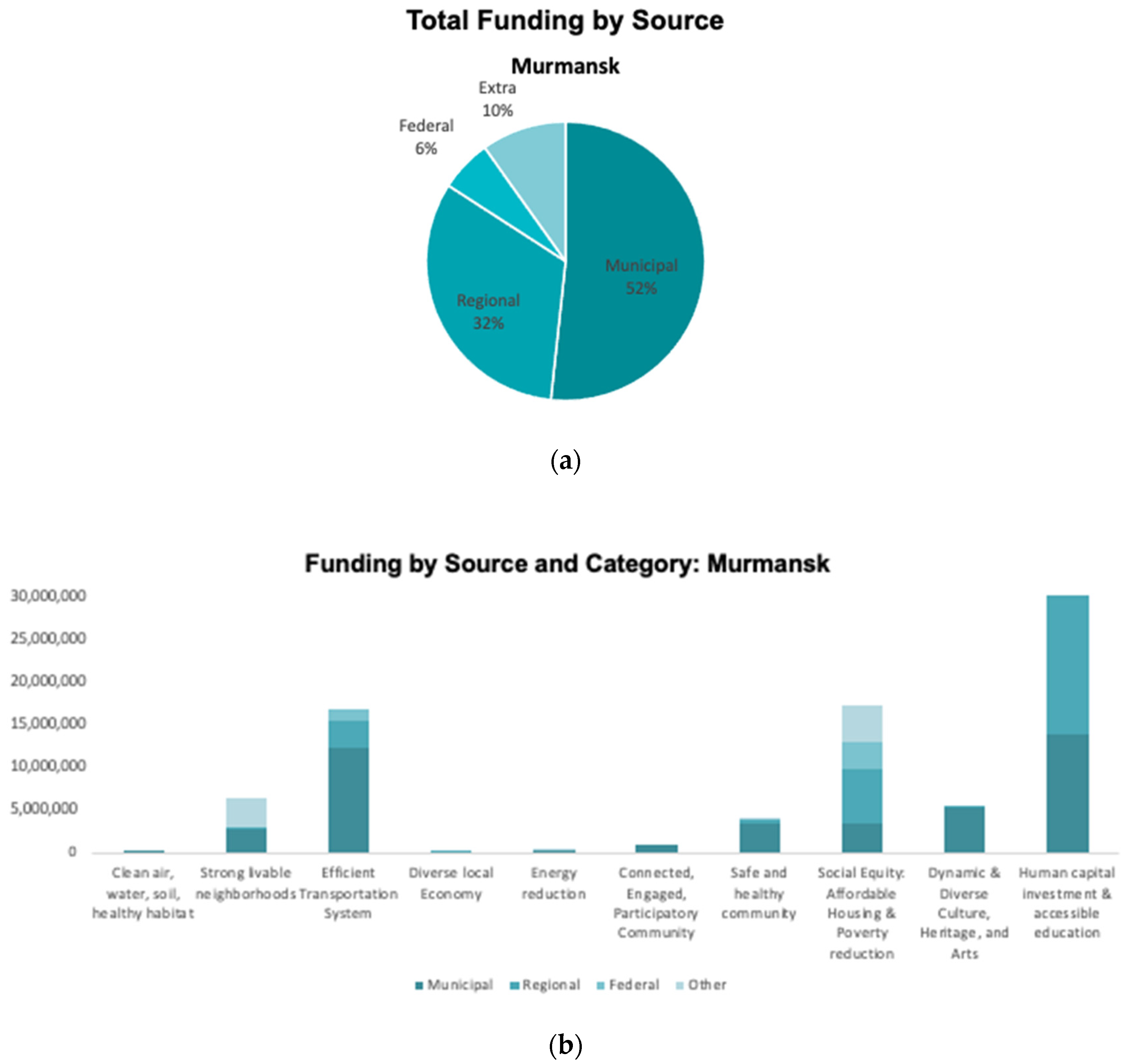Municipal Programs and Sustainable Development in Russian Northern Cities: Case Studies of Murmansk and Magadan
Abstract
:1. Introduction
- How do municipal programs in Murmansk and Magadan address sustainable development?
- What are the key characteristics, strengths and weaknesses of sustainable development municipal programming in the two large Russian Arctic cities?
1.1. Sustainable Development in Urban Communities
1.2. Sustainable Development Policies in Russia
1.3. Sustainable Development Programming in the Russian Arctic
1.4. Sustainable Development in the Russian Urban Arctic
2. Methodology: From Content Analysis to Categorization
2.1. Study Areas
2.1.1. Magadan
2.1.2. Murmansk
3. Results: Typology and Content of Municipal Programs for Sustainable Development
4. Discussion: Strengths and Weaknesses of the Sustainable Development Programming in Murmansk and Magadan
4.1. Comparison to Whitehorse
4.2. Main Programmatic Strengths in the Russian Cities
4.3. Top-Down Nature
4.4. Weak Environmental Programming
4.5. Focus on Material Well-Being
4.6. Bureaucratization and ‘Self-Investment’ by the Local Governments
4.7. Weak Indicators of Success
4.8. Lack of Integration
4.9. Funding Patchwork and Underfunded Mandates
5. Conclusions
Supplementary Materials
Author Contributions
Funding
Institutional Review Board Statement
Informed Consent Statement
Data Availability Statement
Acknowledgments
Conflicts of Interest
References
- Campbell, S. Green Cities, Growing Cities, Just Cities? Urban Planning and the Contradictions of Sustainable Development. In Readings in Planning Theory; Fainstein, S.S., DeFilippis, J., Eds.; John Wiley & Sons, Ltd.: Chichester, UK, 1996; pp. 214–240. ISBN 978-1-119-08467-9. [Google Scholar]
- Mitlin, D.; Satterthwaite, D. Sustainable Development and Cities. In Sustainability, the Environment and Urbanization; Earthscan: London, UK, 1996; pp. 23–62. ISBN 978-1-85383-357-1. [Google Scholar]
- Arctic Sustainability, Key Methodologies and Knowledge Domains: A Synthesis of Knowledge I; Graybill, J.K.; Petrov, A.N. (Eds.) Routledge: London, UK, 2020; ISBN 978-0-429-27701-6. [Google Scholar]
- Broto, V.C.; Trencher, G.; Iwaszuk, E.; Westman, L. Transformative Capacity and Local Action for Urban Sustainability. Ambio 2019, 48, 449–462. [Google Scholar] [CrossRef] [PubMed] [Green Version]
- Reddy, P.S. Localising the Sustainable Development Goals (SDGs). Afr. J. Public Aff. 2016, 9, 1–15. [Google Scholar]
- Jungsberg, L.; Turunen, E.; Heleniak, T.; Wang, S.; Ramage, J.; Roto, J. Atlas of Population, Society and Economy in the Arctic; Nordregio: Stockholm, Sweden, 2019. [Google Scholar]
- Heleniak, T. Arctic migrations. In The Encyclopedia of Global Human Migration; American Cancer Society: Atlanta, GA, USA, 2013; ISBN 978-1-4443-5107-1. [Google Scholar]
- Orttung, R.W. (Ed.) Sustaining Russia’s Arctic Cities: Resource Politics, Migration, and Climate Change, 1st ed.; Berghahn Books: New York, NY, USA, 2016; ISBN 978-1-78533-316-3. [Google Scholar]
- Orttung, R.W. Urban Sustainability in the Arctic: Measuring Progress in Circumpolar Cities; Berghahn Books: New York, NY, USA, 2020; Volume 3, ISBN 978-1-78920-736-1. [Google Scholar]
- Laruelle, M. The Three Waves of Arctic Urbanisation. Drivers, Evolutions, Prospects. Polar Rec. 2019, 55, 1–12. [Google Scholar] [CrossRef]
- Sustainable Development Knowledge Platform. Available online: https://sustainabledevelopment.un.org/index.html (accessed on 18 August 2021).
- United Nations Population Fund. Available online: https://www.unfpa.org/ (accessed on 18 August 2021).
- Heleniak, T.; Bogoyavlensky, D. Arctic Populations and Migration. In Arctic Human Development Report: Regional Processes and Global Linkages; Nordic Council of Ministers: Copenhagen, Denmark, 2015; ISBN 978-92-893-3883-7. [Google Scholar]
- Rasmussen, R.O. (Ed.) Megatrends; Nordic Council of Ministers: Copenhagen, Denmark, 2011; ISBN 978-92-893-2223-2. [Google Scholar]
- Petrov, A.N. Exploring the Arctic’s “Other Economies”: Knowledge, Creativity and the New Frontier. Polar J. 2016, 6, 51–68. [Google Scholar] [CrossRef]
- Petrov, A.N.; Hirshberg, D. Education and Human Capital. In Arctic Human Development Report: Regional Processes and Global Linkages; Nordic Council of Ministers: Copenhagen, Denmark, 2015. [Google Scholar]
- Heleniak, T. The Future of the Arctic Populations. Polar Geogr. 2020, 44, 136–152. [Google Scholar] [CrossRef]
- Haughton, G. Developing Sustainable Urban Development Models. Cities 1997, 14, 189–195. [Google Scholar] [CrossRef]
- Hiremath, R.B.; Balachandra, P.; Kumar, B.; Bansode, S.S.; Murali, J. Indicator-Based Urban Sustainability—A Review. Energy Sustain. Dev. 2013, 17, 555–563. [Google Scholar] [CrossRef]
- ISO 37123:2019. Available online: https://www.iso.org/standard/70428.html (accessed on 18 August 2021).
- Berardi, U. Sustainability Assessment of Urban Communities through Rating Systems. Environ. Dev. Sustain. 2013, 15, 1573–1591. [Google Scholar] [CrossRef]
- United Nations General Assembly. Transforming Our World: The 2030 Agenda for Sustainable Development; United Nations: New York, NY, USA, 2015. [Google Scholar]
- Dempsey, N.; Bramley, G.; Power, S.; Brown, C. The Social Dimension of Sustainable Development: Defining Urban Social Sustainability. Sustain. Dev. 2011, 19, 289–300. [Google Scholar] [CrossRef]
- World Commission on Environment and Development. Report of the World Commission on Environment and Development: Our Common Future; World Commission on Environment and Development: Oslo, Norway, 1987. [Google Scholar]
- Leach, J.M.; Braithwaite, P.A.; Lee, S.E.; Bouch, C.J.; Hunt, D.V.L.; Rogers, C.D.F. Measuring Urban Sustainability and Liveability Performance: The City Analysis Methodology. Int. J. Complex. Appl. Sci. Technol. 2016, 1, 86. [Google Scholar] [CrossRef]
- Hansen, K.G.; Rasmussen, R.O.; Weber, R. Proceedings from the First International Conference on Urbanisation in the Arctic; Ilimmarfik: Nuuk, Greenland, 2012; p. 215. [Google Scholar]
- Raspotnik, A.; Grønning, R.; Herrmann, V. A Tale of Three Cities: The Concept of Smart Sustainable Cities for the Arctic. Polar Geogr. 2020, 43, 64–87. [Google Scholar] [CrossRef]
- Nilsson, A.E.; Larsen, J.N. Making Regional Sense of Global Sustainable Development Indicators for the Arctic. Sustainability 2020, 12, 1027. [Google Scholar] [CrossRef] [Green Version]
- Russian Arctic Cities: Sustainable Development Strategies. In Handbook of Research on International Collaboration, Economic Development, and Sustainability in the Arctic; Practice, Progress, and Proficiency in Sustainability; Sergunin, A. (Ed.) IGI Global: Chicago, IL, USA, 2019; pp. 495–513. ISBN 978-1-5225-6954-1. [Google Scholar]
- Suter, L.; Schaffner, C.; Giddings, C.; Orttung, R.; Streletskiy, D. Developing Metrics to Guide Sustainable Development of Arctic Cities: Progress & Challenges. Arctic Yearbook. 2017, pp. 1–20. Available online: https://www.researchgate.net/profile/Dmitry-Streletskiy/publication/320453847_Developing_Metrics_to_Guide_Sustainable_Development_of_Arctic_Cities_Progress_Challenges/links/59e6b1eeaca2721fc227b28c/Developing-Metrics-to-Guide-Sustainable-Development-of-Arctic-Cities-Progress-Challenges.pdf (accessed on 1 September 2021).
- Zamyatina, N.; Goncharov, R. Arctic urbanization: Resilience in a condition of permanent instability—The case of Russian Arctic cities. In Resilience and Urban Disasters; Edward Elgar Publishing: Cheltenham, UK, 2019; pp. 136–153. [Google Scholar]
- Anisimov, O.A.; Kokorev, V.A. Russian Permafrost in the 21st Century: Model-Based Projections and Analysis of Uncertainties. Earth’s Cryosphere 2017, 21, 3–9. [Google Scholar] [CrossRef]
- Graybill, J. Urban Climate Vulnerability and Governance in the Russian North. Polar Geogr. 2015, 38, 306–320. [Google Scholar] [CrossRef]
- Shiklomanov, N.; Streletskiy, D.; Swales, T.; Kokorev, V. Climate Change and Stability of Urban Infrastructure in Russian Permafrost Regions: Prognostic Assessment Based on GCM Climate Projections. Geogr. Rev. 2017, 107, 125–142. [Google Scholar] [CrossRef]
- Didyk, V. Development Challenges for a Single-Industry Mining Town in the Russian Arctic: The Case of Kirovsk, Murmansk Region. Russ. Anal. Dig. 2015, 172, 2–6. [Google Scholar]
- Pilyasov, A.; Zamyatina, N. Arctic Entrepreneurship: Conditions and Opportunities for Development. Arct. Environ. Econ. Energy 2016, 4, 4–15. [Google Scholar]
- Laruelle, M. New Mobilities and Social Changes in Russia’s Arctic Regions; Routledge: Abingdon, Oxfordshire, UK, 2016; ISBN 978-0-367-66816-7. [Google Scholar]
- Suopajärvi, L.; Poelzer, G.A.; Ejdemo, T.; Klyuchnikova, E.; Korchak, E.; Nygaard, V. Social Sustainability in Northern Mining Communities: A Study of the European North and Northwest Russia. Resour. Policy 2016, 47, 61–68. [Google Scholar] [CrossRef]
- Orttung, R.W. Promoting sustainability in Russia’s Arctic: Integrating local, regional, federal, and corporate interests. In The Challenges for Russia’s Politicized Economic System; Routledge: Abingdon, UK, 2015; ISBN 978-1-315-75778-0. [Google Scholar]
- Kuklina, V.; Ignatieva, S.; Vinokurova, U. Educational Institutions as a Resource for the Urbanization of Indigenous People: The Case of Yakutsk. Sibirica 2019, 18, 29–53. [Google Scholar] [CrossRef]
- Larsen, J.N.; Schweitzer, P.; Petrov, A. Arctic Social Indicators: ASI II: Implementation; Nordisk Ministerråd: Copenhagen, Denmark, 2015; ISBN 0908-6692. [Google Scholar]
- Shiklomanov, N.; Streletskiy, D.; Suter, L.; Orttung, R.; Zamyatina, N. Dealing with the Bust in Vorkuta, Russia. Land Use Policy 2020, 93, 103908. [Google Scholar] [CrossRef]
- Arctic Council. Arctic Resilience Interim Report 2013; Stockholm Environment Institute and Stockholm Resilience Centre: Stockholm, Sweden, 2013. [Google Scholar]
- Xu, Z.; Chau, S.N.; Chen, X.; Zhang, J.; Li, Y.; Dietz, T.; Wang, J.; Winkler, J.A.; Fan, F.; Huang, B.; et al. Assessing Progress towards Sustainable Development over Space and Time. Nature 2020, 577, 74–78. [Google Scholar] [CrossRef]
- Sobranie Zakonodatel’stva Rossiiskoi Federatsii St. 4 Federalnii Zakon Ot 28 Ijunya 2014 g. N 172-FZ. O Strategicheskom Planirovanii v Rossijskoj Federacii. 2014. Available online: http://www.consultant.ru/document/cons_doc_LAW_164841/ (accessed on 20 June 2014).
- Russian Federation. Sobranie zakonodatel’stva Rossiiskoi Federatsii Budjetnii Kodeks Rossijskoj Federacii Ot 31 Ijulya 1998 g. N 145-FZ; Russian Federation: Moscow, Russia, 1998.
- Oldfield, J.D. Russia, Systemic Transformation and the Concept of Sustainable Development. Environ. Polit. 2001, 10, 94–110. [Google Scholar] [CrossRef]
- Russian Federation. Report on Implementing the Principles of Sustainable Development in the Russian Federation. Russian Outlook on the New Paradigm for Sustainable Development. Preparing for “RIO + 20”. Russian Federation: Moscow, Russia, 2012. [Google Scholar]
- Bobylev, S.N.; Solovyeva, S.V. Sustainable Development Goals for the Future of Russia. Stud. Russ. Econ. Dev. 2017, 28, 259–265. [Google Scholar] [CrossRef]
- United Nations Statistical Commission. Technical Report by the Bureau of the United Nations Statistical Commission (UNSC) on the Process of the Development of an Indicator Framework for the Goals and Targets of the Post-2015 Development Agenda (Working Draft); United Nations Statistical Commission: New York, NY, USA, 2015. [Google Scholar]
- Russian Federation. Voluntary National Review of the Progress Made in the Implementation of the 2030 Agenda for Sustainable Development; Analytical Center for the Government of the Russian Federation: Moscow, Russia, 2020.
- Sergunin, A. Indexing Arctic Urban Sustainable Development Planning Strategies: The Case of Russia. Arctic Yearbook. 2018, p. 75. Available online: https://www.ucviden.dk/ws/portalfiles/portal/102978069/Arctic_Yearbook_2018.pdf#page=77 (accessed on 1 September 2021).
- Ministerstvo Kul’tury. Doklad. Ustojchivoe Razvitie Korennyh Malochislennyh Narodov. Opyt Rossii. Itogi Vtorogo Mezhdunarodnogo Desjatiletija Korennyh Narodov Mira; Ministerstvo kul’tury: Moscow, Russia, 2015.
- Mazurov, Y.; Sulyandziga, R.; Vronsky, N. Sustainable Development Goals 2030 and Indigenous Peoples of the North, Siberia, and the Far East: From Awareness to Participation. “No One Left Behind”. Libr. Indig. Peoples North 2018. [Google Scholar]
- Emelyanova, E. The Financial Backbone of the Municipal Investment Policy in the Towns of the Far North. Arct. North 2014, 15, 15–34. [Google Scholar]
- Berkman, P.; Vylegzhanin, A.; Young, O. Baseline of Russian Arctic Laws; Springer Nature Switzerland AG: Cham, Switzerland, 2019; ISBN 978-3-030-06261-3. [Google Scholar]
- Petrov, A. Russia’s Arctic Policies: Historical Legacies, Current Implementation and International Cooperation. In The Arctic in World Affairs. A North Pacific Dialogue on Global-Arctic Interactions: The Arctic Moves from Periphery to Center; Corell, R., Kim, J.D., Kim, Y.H., Moe, A., Morrison, C.E., VanderZwaag, D.L., Young, O.R., Eds.; KMI Press: Busan, Korea; East-West Center: Honolulu, HI, USA, 2019. [Google Scholar]
- Orttung, R.W.; Reisser, C. Urban Sustainability in Russia’s Arctic: Lessons from a Recent Conference and Areas for Further Investigations. Polar Geogr. 2014, 37, 193–214. [Google Scholar] [CrossRef]
- Henry, L.A. Thinking globally, limited locally: The Russian environmental movement and sustainable development. In Environmental Justice and Sustainability in the Former Soviet Union; MIT Press: Cambridge, MA, USA, 2009; pp. 47–69. ISBN 978-0-262-51233-6. [Google Scholar]
- Vernadsky, V.I. Biosfera i Noösfera; Airis Press: Moscow, Russia, 2002. [Google Scholar]
- Oldfield, J.D.; Shaw, D.J.B. V.I. Vernadsky and the Noosphere Concept: Russian Understandings of Society–Nature Interaction. Geoforum 2006, 37, 145–154. [Google Scholar] [CrossRef] [Green Version]
- Graybill, J.K. Continuity and Change: (Re)Constructing Environmental Geographies in Late Soviet and Post-Soviet Russia. Area 2007, 39, 6–19. [Google Scholar] [CrossRef]
- Bartniczak, B.; Raszkowski, A. Sustainable Development in the Russian Federation—Indicator-Based Approach. Probl. Ekorozwoju—Probl. Sustain. Dev. 2017, 12, 133–142. [Google Scholar]
- Fauzer, V.V.; Lytkina, T.S.; Fauzer, G.N. Features of Population Settlement in the Arctic Zone of Russia. Arct. Ecol. Econ. 2016, 2, 40–50. [Google Scholar]
- Rozanova, M. Indigenous Urbanization in Russia’s Arctic: The Case of Nenets Autonomous Region. Sibirica 2019, 18, 54–91. [Google Scholar] [CrossRef]
- Laruelle, M. Postcolonial Polar Cities? New Indigenous and Cosmopolitan Urbanness in the Arctic. Acta Boreal. 2019, 36, 149–165. [Google Scholar] [CrossRef]
- Stocker, T.F.; Qin, D.; Plattner, G.-K.; Tignor, M.; Allen, S.K.; Boschung, J.; Nauels, A.; Xia, Y.; Bex, V.; Midgley, P.M. Climate Change 2013: The Physical Science Basis. Contribution of Working Group I to the Fifth Assessment Report of the Intergovernmental Panel on Climate Change; IPCC: New York, NY, USA; Cambridge University Press: Cambridge, UK, 2018; p. 1535. [Google Scholar]
- Hassol, S. Impacts of a Warming Arctic—Arctic Climate Impact Assessment; Cambridge University Press: Cambridge, UK, 2004; ISBN 978-0-521-61778-9. [Google Scholar]
- Box, J.E.; Colgan, W.T.; Christensen, T.R.; Schmidt, N.M.; Lund, M.; Parmentier, F.-J.W.; Brown, R.; Bhatt, U.S.; Euskirchen, E.S.; Romanovsky, V.E.; et al. Key Indicators of Arctic Climate Change: 1971–2017. Environ. Res. Lett. 2019, 14, 045010. [Google Scholar] [CrossRef]
- Hock, R. Glacier Melt: A Review of Processes and Their Modelling. Prog. Phys. Geogr. Earth Environ. 2005, 29, 362–391. [Google Scholar] [CrossRef]
- Grosse, G.; Romanovsky, V.; Jorgenson, T.; Anthony, K.W.; Brown, J.; Overduin, P.P.; Wegener, A. Vulnerability and Feedbacks of Permafrost to Climate Change. EOS Trans. Am. Geophys. Union 2011, 92, 73–74. [Google Scholar] [CrossRef]
- Suter, L.; Streletskiy, D.; Shiklomanov, N. Assessment of the Cost of Climate Change Impacts on Critical Infrastructure in the Circumpolar Arctic. Polar Geogr. 2019, 42, 267–286. [Google Scholar] [CrossRef]
- Hjort, J.; Karjalainen, O.; Aalto, J.; Westermann, S.; Romanovsky, V.E.; Nelson, F.E.; Etzelmüller, B.; Luoto, M. Degrading Permafrost Puts Arctic Infrastructure at Risk by Mid-Century. Nat. Commun. 2018, 9, 5147. [Google Scholar] [CrossRef]
- Streletskiy, D.A.; Suter, L.J.; Shiklomanov, N.I.; Porfiriev, B.N.; Eliseev, D.O. Assessment of Climate Change Impacts on Buildings, Structures and Infrastructure in the Russian Regions on Permafrost. Environ. Res. Lett. 2019, 14, 025003. [Google Scholar] [CrossRef]
- Doloisio, N.; Vanderlinden, J.-P. The Perception of Permafrost Thaw in the Sakha Republic (Russia): Narratives, Culture and Risk in the Face of Climate Change—ScienceDirect. Polar Sci. 2020, 26, 100589. [Google Scholar] [CrossRef]
- Nyland, K.E.; Klene, A.E.; Brown, J.; Shiklomanov, N.I.; Nelson, F.E.; Streletskiy, D.A.; Yoshikawa, K. Traditional Iñupiat Ice Cellars (SIĠḷUAQ) in Barrow, Alaska: Characteristics, Temperature Monitoring, and Distribution. Geogr. Rev. 2017, 107, 143–158. [Google Scholar] [CrossRef]
- Øverland, I. Russia’s Arctic Energy Policy. Int. J. 2010, 65, 865–878. [Google Scholar] [CrossRef] [Green Version]
- Petrov, A. Marginal Places in Discursive Space: Political Economies of Development and Urban Space Planning in the North, Conceptual Shifts. In Proceedings of the First International Conference on Urbanisation in the Arctic, Nuuk, Greenland, 28–30 August 2012. [Google Scholar]
- Evseev, A.V.; Krasovskaya, T.M. Toxic Metals in Soils of the Russian North. J. Geochem. Explor. 2017, 174, 128–131. [Google Scholar] [CrossRef]
- Karnaeva, A.; Kulikova, O.; Mazlova, E.; Buryak, A. Aged Diesel and Heavy Metal Pollution in the Arctic Tundra (Yamal Peninsula, Russia). Sci. Total Environ. 2021, 792, 148471. [Google Scholar] [CrossRef] [PubMed]
- Sovet Deputatov Goroda Murmanska Reshenie Ot 27 Marta 2015 Goda N 10-135 Ob Utverzhdenii Polozhenija o Strategicheskom Planirovanii v Gorode Murmanske. Available online: https://docs.cntd.ru/document/432826113 (accessed on 19 August 2021).
- Magadanskaja Gorodskaya Duma. O Strategicheskom Plane (Koncepcii Strategicheskogo Razvitija) Goroda Magadana Na Period Do 2020 Goda Ot 19 Oktjabrja 2007. Available online: https://docs.cntd.ru/document/441590997/ (accessed on 19 October 2007).
- Federal State Statistics Service (Russia). Available online: https://eng.rosstat.gov.ru/ (accessed on 19 August 2021).
- Malkina, M. Decomposition of Spatial Inequality in Budget Provision by Income Sources: Case of Modern Russia. In Proceedings of the European Financial Systems 2017, Brno, The Czech Republic, 26–27 June 2017; Volume 2, pp. 35–43. [Google Scholar]
- Yushkov, A. Fiscal Decentralization and Regional Economic Growth: Theory, Empirical Studies, and Russian Experience. Vopr. Econ. 2015, 1, 404–418. [Google Scholar] [CrossRef] [Green Version]




| Whitehorse Sustainability Plan | Modified Classification for Murmansk and Magadan |
|---|---|
|
|
Publisher’s Note: MDPI stays neutral with regard to jurisdictional claims in published maps and institutional affiliations. |
© 2021 by the authors. Licensee MDPI, Basel, Switzerland. This article is an open access article distributed under the terms and conditions of the Creative Commons Attribution (CC BY) license (https://creativecommons.org/licenses/by/4.0/).
Share and Cite
Degai, T.S.; Khortseva, N.; Monakhova, M.; Petrov, A.N. Municipal Programs and Sustainable Development in Russian Northern Cities: Case Studies of Murmansk and Magadan. Sustainability 2021, 13, 12140. https://doi.org/10.3390/su132112140
Degai TS, Khortseva N, Monakhova M, Petrov AN. Municipal Programs and Sustainable Development in Russian Northern Cities: Case Studies of Murmansk and Magadan. Sustainability. 2021; 13(21):12140. https://doi.org/10.3390/su132112140
Chicago/Turabian StyleDegai, Tatiana S., Natalia Khortseva, Maria Monakhova, and Andrey N. Petrov. 2021. "Municipal Programs and Sustainable Development in Russian Northern Cities: Case Studies of Murmansk and Magadan" Sustainability 13, no. 21: 12140. https://doi.org/10.3390/su132112140






